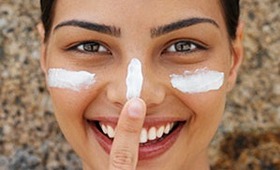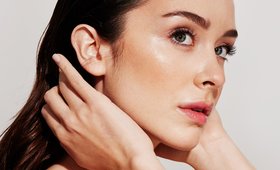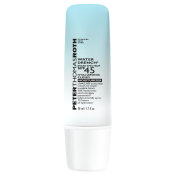
As we head into the warmer months, sun protection is top of mind. Whether you’re SPF-savvy or still getting used to the idea of applying sunscreen every day, the facts around sun protection can be murky at best. Even those of us who think we know better can buy into myths and misconceptions around SPF. We look at the science to debunk some of the common beliefs about sunscreen that you might hear this summer.
1. Chemical sunscreen absorbs UV rays; mineral sunscreen reflects them.
Both chemical and mineral (physical) filters used in sunscreens absorb UV rays and convert them into heat. This myth probably stems from the fact that mineral sunscreens do reflect a small amount of UV rays (around 10%), but their UV-protective power mainly comes from their ability to absorb UV rays.
2. Mineral sunscreens last longer than chemical sunscreens, so you don’t have to reapply them as often.
No matter what type of filter ingredients your sunscreen uses, you should reapply every two hours of sun exposure. While it was once believed that chemical sunscreens are less photostable than mineral sunscreens, research shows that with most chemical filters, that’s not true.
3. The higher the SPF, the longer you’re protected.
“SPF” refers to how long UVB rays would take to redden your skin when using the product exactly as directed—and truthfully, most people don’t wear sunscreen under the same conditions as a lab. Whether your sunscreen is SPF 30 or SPF 50, it’s best to reapply every two hours, just like the label suggests.
4. You need to wear sunscreen even if you’re indoors.
This one is partially true—in reality, it depends on how much UV exposure you’re getting wherever you are inside. Calculating your UV exposure is a complicated process and can vary based on how close you’re sitting to a window, what time of day it is, and more. According to this blog post by cosmetic chemist Michelle Wong, if you’re sitting around one meter away from a window with less than 2% sky view, you’re probably getting around 1% of the amount of UV you would get from being outdoors in direct sunlight. All in all, it’s your call—but the UV exposure you get indoors may be less of a concern than you originally thought.
5. “Reef-safe” sunscreens won’t harm coral reefs.
The truth is, there’s no regulated or official definition of “reef-safe” or “reef-friendly”—no matter what the label on your sunscreen says. What’s more, the studies linking sunscreen to coral reef bleaching are contentious at best. Based on the data we have today, it’s more likely that bigger issues like climate change are behind coral bleaching—not your sunscreen.
Featured Products
You Might Also Like
-

Hair
How to Protect Your Hair Color from Sun Damage
-

Sun Protection
10 Beach Bag Beauty Must-Haves
- 154
-

Sun Protection
Natural Looking Sunscreen
- 29
-

Sun Protection
The Best Products to Prevent Wrinkles
- 75
-

Blemish & Acne Treatments
So Long, Summer Breakouts!
- 77
-

Sun Protection
5 Popular Sunscreen Myths—Debunked













